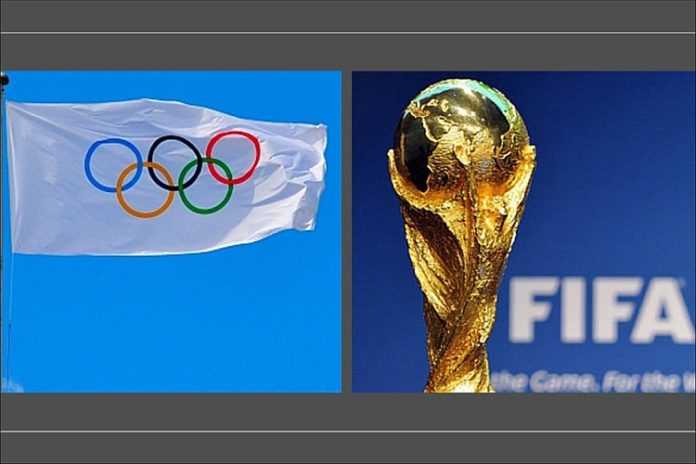★ The Sports Examiner: Chronicling the key competitive, economic and political forces shaping elite sport and the Olympic Movement.★
★ Enjoying our coverage? If so, please consider a donation to help cover technical costs for 2023. Thank you for your support. ★
★ To get The Sports Examiner by e-mail: sign up here! ★
After Sunday’s rapturous FIFA World Cup Final that saw Argentina and France battle all the way to penalty kicks, combined with the staggering announcement of FIFA’s $11 billion budget for 2023-26, it’s worth asking whether the Olympic Games – and the International Olympic Committee – have been displaced as the world’s biggest sporting event.
Despite all of the issues raised in the run-up to the tournament, it more than lived up to expectations. According to FIFA:
● More than 3.4 million live spectators, with average attendance at 96.3% of capacity;
● Worldwide television audience of about two billion for the group stage and “approaching” five billion for the tournament (this figure will not be finalized for some months);
● More than 1.8 million attendance at the FIFA Fan Festival in Doha (average of more than 70,000 per day);
● More than 1.9 million Hayya Cards – essentially a temporary visa – were approved, with Saudi Arabia, India and the U.S. the top originating countries for foreign visitors.
These are impressive figures, but not as impressive as the announcements by FIFA President Gianni Infantino (SUI) concerning the future.
= FIFA vs. IOC: Revenue =
The FIFA Council approved a stunning budget of $11 billion for the 2023-26 time frame, a 47% increase from the 2019-22 total of $7.5 billion.
Infantino said the expectations for the 2026 World Cup, to be held in Canada, Mexico and the U.S., are for five to five-and-a-half million visitors for the tournament, which will expand from 32 to 48 teams in a format yet to be determined.
These are staggering numbers, and show FIFA estimating it will triple its four-year revenues between the 2006 World Cup in Germany and the 2022 World Cup in Qatar, and then rise 47% just by 2026:
● 2003-06: $2.634 billion
● 2007-10: $4.189 billion, an increase of 59%
● 2011-14: $5.712 billion, an increase of 36%
● 2015-18: $6.421 billion, an increase of 12%
● 2019-22: $7.5 billion estimated, an increase of 17%
● 2023-26: $11.0 billion budgeted, an increase of 47%
Infantino points out that the budget of $6.44 billion for 2019-22 was exceeded despite the Covid-19 pandemic that started in 2020 and has not yet been thoroughly conquered.
By comparison, what about the International Olympic Committee? It is no slouch, either, also working on quadrennial budgets, but tied to different years. The IOC’s revenues:
● 2000-04: $3.0 billion
● 2005-08: $3.9 billion, an increase of 30%
● 2009-12: $5.2 billion, an increase of 33%
● 2013-16: $5.7 billion, an increase of 10%
● 2017-20: $7.6 billion, an increase of 33%
● 2021-24: ???
This nearly mirrors FIFA’s growth over time; a 2021-24 budget was not included in the IOC’s Annual Report for 2021, in part due to the complications from the postponement of the 2020 Tokyo Games to 2021. But the Olympic Solidarity program, which supports the National Olympic Committees, is already committed to grow in the 2021-24 timeframe from $509 million to $590 million, an increase of 16%. At that rate, the IOC’s revenues for 2021-24 would be about $8.8 billion, ahead of FIFA for the 2019-22 period and also heading toward its major event being in the United States – specifically Los Angeles – for 2028.
(Although no 2021-24 budget was shown, the IOC did state that it has revenues of $4.1 billion already secured for the 2029-32 timeframe.)
(For American fans, it’s worthwhile to note that the leading U.S. professional leagues earn as much or more in a single season as FIFA and the IOC earn in a quadrennial. The National Football League (and its teams) was reported to gross $17.04 billion in 2021, with about $11 billion for Major League Baseball in 2022 and more than $10 billion for the National Basketball Association in 2021-22.)
= FIFA World Cup vs. Olympic Games: Audience =
Money is one measure; what about the audience, and in specific, the worldwide viewing audience on television and other devices?
Both FIFA and the IOC have commissioned viewing studies of their mega-events, and while the World Cup is expanding, the Olympic audience has shrunk of late:
FIFA World Cup:
● 2010: 3.20 billion on television
● 2014: 3.19 billion on television
● 2018: 3.57 billion total viewers
● 2022: FIFA said “approaching five billion”
Olympic Games:
● 2012: 3.6 billion on television; 1.2 billion digital users
● 2016: 3.2 billion on television; 1.3 billion digital users
● 2020: 3.05 billion total viewers
The studies for the 2018 FIFA World Cup and the Tokyo 2020 Olympic Games were both done by the same firm: Publicis Sport & Entertainment. Please note the Olympic audience figures for TV and digital in 2012 and 2016 are not discrete and there is quite a bit of overlap.
= FIFA World Cup vs. Olympic Games: Participation =
Here we see the enormous differences in these events, despite their similarity in funding and audience. Please note FIFA defines what is widely known as the “World Cup” as the “World Cup Finals” as it is the final tournament of teams which have qualified over a two-year period.
Athletes and teams/qualification:
● FIFA World Cup: About 5,500 players from 211 members
● Olympic Games: Estimated 100,000 athletes from 206 National Olympic Committees
Athletes and teams/main event:
● FIFA World Cup: 832 players on 32 national teams (1,248 in 2026)
● Olympic Games: 10,500 athletes from 206 National Olympic Committees
Hours of competition:
● FIFA World Cup: 128 from 64 matches of two hours each
● Olympic Games: 3,800 from 17 days, in 32 sports at Tokyo 2020
These numbers bring out the contrast between the events, especially in that the World Cup builds from teams in group-stage play to a crescendo as countries are eliminated and the final decides the ultimate, single championship that is the most-watched event.
The Olympic Games is exactly the opposite, with the biggest single audience for the Opening Ceremony, in which every country attending the Games is showcased. After that, the audiences splinter into events of choice, with athletics, gymnastics and swimming the most popular, but with 339 events in 32 sports in Tokyo – all shown live – there was plenty to choose from for more than 17 days.
Which is the best?
There is no way for the ascending FIFA World Cup to displace the Olympic Games in that for fans in more than 200 countries around the world, athletes from their nation participate almost daily in the Olympics. Only 32 countries competed in the 2018 World Cup and even with expansion to 48 in 2026, it’s still only a fraction of the countries in the Games.
But FIFA has had success now with staging World Cups in places the IOC has not gone. The World Cup has been held in Africa – South Africa in 2010 – and now in the Middle East, in Qatar. Both of those countries have either bid for, or want to bid for, the Olympic Games, but the pressure on a single city or metropolitan area to host 30-plus sports over 17 days is far greater than the World Cup schedule of not more than four matches a day.
The Olympic worldwide broadcast audience has thinned by about 15% since London in 2012 and there are high hopes for Paris in 2024 and Los Angeles in 2028 as magnets to draw fans back in. But for FIFA, the future seems limitless after a difficult, but ultimately brilliant tournament that concluded with one of the most memorable games in sports history.
Rich Perelman
Editor
You can receive our exclusive TSX Report by e-mail by clicking here. You can also refer a friend by clicking here, and can donate here to keep this site going.
For our updated, 951-event International Sports Calendar for 2022-23 and beyond, by date and by sport, click here!























